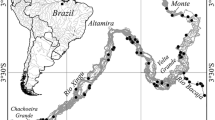Abstract
Mesopelagic fishes were collected from depths of 400 to 900 m off Oregon (USA) in September 1983, October 1985 and June 1989. Species of mesopelagic fish without diel vertical migrations (non-migrators) are known to have high body-and muscle-water contents relative to epipelagic and vertically migrating mesopelagic species. This characteristic is reported to correlate with low food availability. Through histology, we show that four species of swimbladderless non-migrators (Bathylagus pacificus, B. milleri, Tactostoma macropus and Chauliodus macouni) have large deposits of gelatinous material which stain positively for acidic glycosaminoglycans (GAGs) and negatively for lipid and protein. GAGs are highly hygroscopic and are thus responsible in part for the high body-water content of these species. The material is located between myotomal (swimming) muscle cells, along the dorsal midline and surrounding the spine in all four species, and the two Bathylagus species have an additional subcutaneous layer. The subcutaneous layer of B. pacificus has very high (96%) water, low protein (3%) and low ion contents and is positively buoyant, unlike myotomal muscle (89% water, 6.7% protein, negatively buoyant). In contrast, four species of vertical migrators (B. ochotensis, Stenobrachius leucopsarus, Tarletonbeania crenularis and Diaphus theta) have no such deposits. The role of this gelatinous material as a possible buoyancy mechanism in an energy-poor habitat is discussed.
Similar content being viewed by others
Literature cited
Air Force Institute of Pathology (1960). Manual of histologic and special staining techniques. McGraw Hill, New York
Bailey, T. G., Robison, B. H. (1986). Food availability as a selective factor on the chemical compositions of midwater fishes in the eastern North Pacific. Mar. Biol. 91: 131–141
Belanger, L. F. (1963). Comparisons between different histochemical and histophysical techniques as applied to mucus-secreting cells. Ann. N.Y. Acad. Sci. 106: 364–378
Bidigare, R. R., Biggs, D. C. (1980). The role of sulfate exclusion in buoyancy maintenance by siphonophores and other oceanic gelatious zooplankton. Comp. Biochem. Physiol. 66A: 467–471
Blaxter, J. H. S., Wardle, C. S., Roberts, B. L. (1971). Aspects of the circulatory physiology and muscle systems of deep-sea fish. J. mar. biol. Ass. U.K. 51: 991–1006
Butler, J. L., Pearcy, W. G. (1972). Swimbladder morphology and specific gravity of myctophids off Oregon. J. Fish. Res. Bd Can. 29: 1145–1150
Childress, J. J., Nygaard, M. H. (1973). The chemical composition of midwater fishes as a function of depth of occurrence off southern California. Deep-Sea Res. 20: 1093–1109
Childress, J. J., Taylor, S. M., Cailliet, G. M., Price, M. H. (1980). Patterns of growth, energy utilization and reproduction in some mesopelagic and bathypelagic fishes off southern California. Mar. Biol. 61: 27–40
Cohen, D. M. (1964). Suborder Argentinoidea. Mem. Sears Fdn mar. Res. 1: 1–70
Comper, W. D., Laurent, T. C. (1978). Physiological function of connective tissue polysaccharides. Physiol. Rev. 58: 255–315
Deitch, A. D. (1955). Microspectrophotometric study of the binding of the anionic dye, Naphthol Yellow S, by tissue sections and purified proteins. Lab. Invest. 4: 324–351
Denton, E. J., Marshall, N. B. (1958). The buoyancy of bathypelagic fishes without a gas-filled swimbladder. J. mar. biol. Ass. U.K. 37: 753–767
DeVries, A. L., Eastman, J. T. (1978). Lipid sacs as a buoyancy adaptation in an Antarctic fish. Nature, Lond. 271: 352–353
Eastman, J. T., DeVries, A. L. (1981). Buoyancy adaptations in a swim-bladderless Antarctic fish. J. morph. 167: 91–102
Griffith, R. W. (1981). Composition of the blood serum of deep-sea fishes. Biol. Bull. mar. biol. Lab., Woods Hole 160: 250–264
Gurr, E. (1958). Methods of analytical histology and histochemistry. Leonard Hill, London
Gurr, E. (1965). Rational uses of dyes in biology. Williams & Wilkins, Baltimore
Hulet, W. H., Fischer, J., Rietberg, B. J. (1972). Electrolyte composition of anguilliform leptocephali from the Straits of Florida. Bull. mar. Sci. 22: 432–448
Leivstad, H. (1971). Osmotic and ionic conditions in pelagic teleost eggs. Acta physiol. scand. 82: p. 12A
Madin, L. P., Cetta, C. M., McAlister, V. L. (1981). Elemental and biochemical composition of salps (Tunicata: Thaliacea). Mar. Biol. 63: 217–226
Marshall, N. B. (1954). Aspects of deep-sea biology. Philosophical Library, New York
Marshall, N. B. (1960). Swimbladder structure of deep-sea fishes in relation to their systematics and biology. Discovery' Rep. 31: 1–122
Marshall, N. B. (1971). Explorations in the life of fishes. Harvard, Cambridge, USA
Morrow, J. E., Jr. (1964). Suborder Stomiatoidea. General discussion and key to families. Mem. Sears Fdn mar. Res. 1: 71–77
Neighbors, M. A. (1988). Triacylglycerols and wax esters in the lipids of deep midwater teleost fishes of the Southern California Bight. Mar. Biol. 98: 15–22
Neighbors, M. A., Nafpaktitis, B. G. (1982). Lipid compositions, water contents, swimbladder morphologies and buoyancies of nineteen species of midwater fishes (18 myctophids and 1 neoscopelid). Mar. Biol. 66: 207–215
Pearcy, W. G., Krygier, E. E., Mesecar, R., Ramsey, F. (1977). Vertical distribution and migration of oceanic micronekton off Oregon. Deep-Sea Res. 24: 223–245
Pfeiler, E. (1986). Towards an explanation of the developmental strategy in leptocephalus larvae of marine teleost fishes. Envir. Biol. Fish. 15: 3–13
Prosser, C. L. (1973). Inorganic ions. In: Prosser, C. L. (ed) Comparative animal physiology, 3rd ed. Saunders, Philadelphia/London/Toronto
Siebenaller, J. F., Yancey, P. H. (1984). Protein composition of white skeletal muscle from mesopelagic fishes having different water and protein contents. Mar. Biol. 78: 129–137
Willis, J. M., Pearcy, W. G. (1980). Spatial and temporal variations in the population size structure of three lanternfishes (Myctophidae) off Oregon, USA. Mar. Biol. 57: 181–191
Willis, J. M., Pearcy, W. G. (1982). Vertical distribution and migration of fishes of the lower mesopelagic zone off Oregon. Mar. Biol. 70: 87–98
Author information
Authors and Affiliations
Additional information
Communicated by P. C. Schroeder, Pullman
Rights and permissions
About this article
Cite this article
Yancey, P.H., Lawrence-Berrey, R. & Douglas, M.D. Adaptations in mesopelagic fishes. Mar. Biol. 103, 453–459 (1989). https://doi.org/10.1007/BF00399577
Accepted:
Issue Date:
DOI: https://doi.org/10.1007/BF00399577




